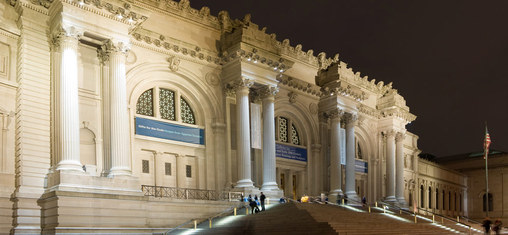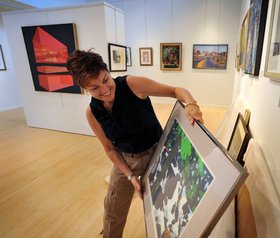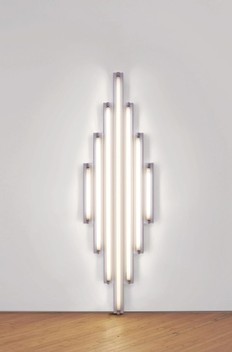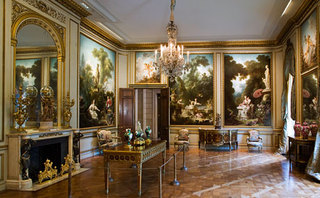The sneaky big Metropolitan Museum* changed its website over the weekend, as I just discovered by accident. (No press release was sent and none has been posted.) There is now a press release — not yet posted online. But I’ve posted the guts at the end of my initial post. Now it is posted here.
I went looking for information about an exhibit, and found a gigantic, beautiful picture of the Met’s exterior, at night (below), at the URL, which rotates with four exhibition photos. In the right corner, on the bottom, was “Welcome to Our Newly Redesigned Website,” a note from director Thomas P. Campbell, dated yesterday. He wrote:
Since becoming Director, I have stressed two priorities: scholarship and accessibility. Our new website, which launched today, certainly embodies both of these aims, featuring complete listings of the Museum’s catalogued collections, an interactive map–with descriptions of every gallery in the Main Building and at The Cloisters–suggested itineraries to help you plan your visit, special content for Members, and much more. Of course, favorite sections still remain, like the constantly evolving Heilbrunn Timeline of Art History and Connections, which takes us on personal journeys through the collection.
On first glance, it looks good — not least because the pictures are much bigger.
 The tabs are pretty much the same as before and/or most museums: Visit, Exhibitions, Collections, Events, Learn, Research, Give and Join, About the Museum and Shop. Hours are posted on the main page (yeah!), and there are links to events in the next seven days. “Now at the Met” is right there on the right. And there’s a video link on the bottom, along with links to Kid’s stuff and the store.
The tabs are pretty much the same as before and/or most museums: Visit, Exhibitions, Collections, Events, Learn, Research, Give and Join, About the Museum and Shop. Hours are posted on the main page (yeah!), and there are links to events in the next seven days. “Now at the Met” is right there on the right. And there’s a video link on the bottom, along with links to Kid’s stuff and the store.
It’s going to take me, and others, a while to explore all the changes — right now, it’s the presentation that seems to have changed, rather than the content, though there may be much more of that.
UPDATED: Yes, indeed, there is far more content, good content, although some old pages seem to have disappeared (e.g, where’s the “American Stories” exhibition page?).
From the press release–
New general features of www.metmuseum.org include:
* Overviews of nearly 400 galleries at the Museum with a description and photograph of each, highlighted works of art within the gallery, and links to related content.
* The complete holdings of many collections within the Met are now accessible online, totaling more than 340,000 works of art and including all works from the Museum’s collection currently on view. Additional object records will be posted on an ongoing basis, with the goal of establishing records online for the remainder of the collection as expeditiously as possible. These records include links to the Heilbrunn Timeline of Art History, an exceptional resource providing chronological, geographical, and thematic explorations of the history of art from around the world, as illustrated by the Museum’s collections.
* A new design–elegant, clean, and simple–that brings the Met’s vast online resources into a unified website with a consistent look-and-feel, simplified navigation, and improved layout.
* A new and powerful search interface for the collections that accommodates complex searches, browsing, and simple ways to narrow results, as well as recommendations of related objects.
* High-resolution images of many of the works of art, with zooming functionality allowing for detailed exploration and analysis.
* A Media Gallery that centralizes an extensive range of videos, interactive features, and other interpretive media for visitors to enjoy.
* A Give & Join section with special content for Museum Members and information on ways to support the Museum.
New features to enhance or assist in planning visits to the Museum are:
* An interactive floor plan that can be used to locate galleries and special exhibitions, as well as facilities across the Museum. Each gallery links to an overview page featuring a description and photograph of the gallery, highlighted works of art, and links to related content.
* Suggested itineraries to help navigate the Met’s extensive collections, including maps, estimated durations, and insights and stories to enhance the journeys. One of the itineraries currently available is a tour of works selected and with commentary by the Museum’s Director Thomas P. Campbell.
Photo Credit: Courtesy of the Met
*I consult to a foundation that supports the Met



